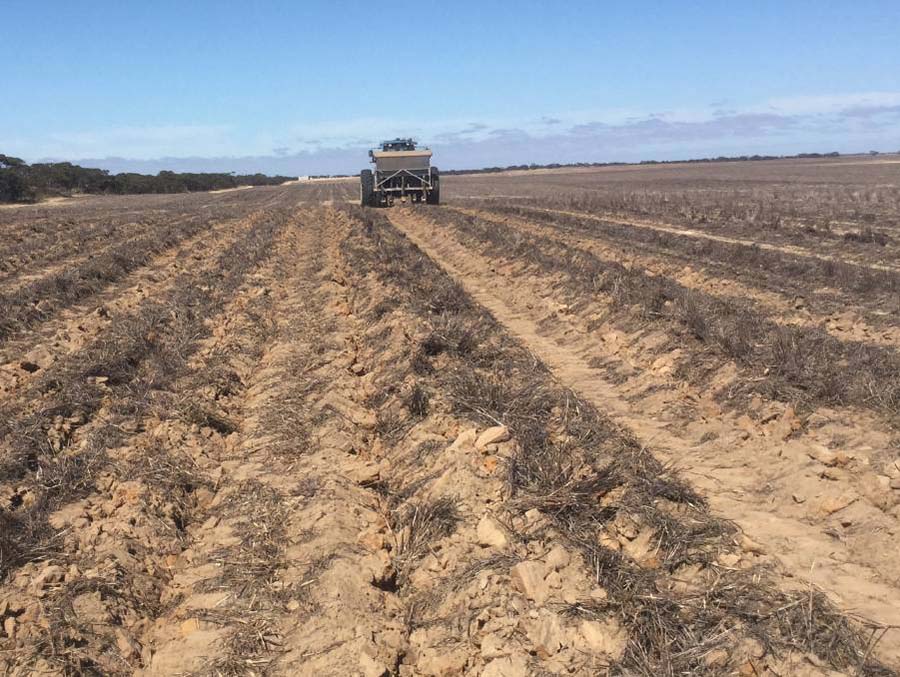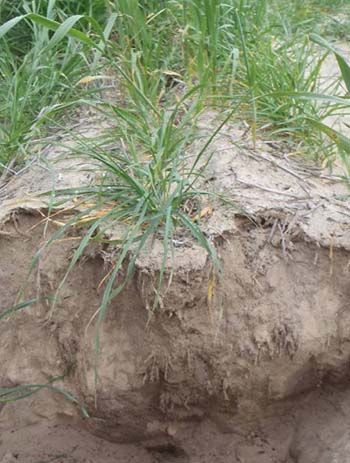Key points
- Participatory research is aiding grower adoption of techniques to address soil constraints on the Eyre Peninsula, especially on sandy soils.
- Adding topsoil inclusion plates to deep rippers is an effective way to ameliorate sandy soils in south-eastern Australia, showing yield improvements of up to 1.5t/ha.
In 2015, GRDC invested in a five-year R&D project, with a consortium of partners led by CSIRO, investigating constraints to sandy soils in the low to medium-rainfall environments of south-eastern Australia.
Two years later, a validation and demonstration program was developed to more widely test soil interventions and research outcomes arising from the project.
The Sands Impacts component of the GRDC program, in partnership with grower groups, is enabling growers to more confidently identify and address the primary constraints to crop productivity on sandy and duplex soils.
Sandy soils can have multiple constraints, which limit crop rooting depth and water and nutrient extraction, including water repellence, soil acidity, compaction and low organic carbon levels, leading to poor biological activity and nitrogen mineralisation - and consequently decreased crop productivity.
The current developments built upon even earlier research conducted by the Primary Industries and Regions SA (PIRSA) 'New Horizons' program, which showed long-term yield gains from the incorporation of organic material at three sandy sites, and mixing soils with a spader to overcome water repellency at two sites.
Much foundational work was also conducted in Western Australia, where sandy soils dominate cropping regions.
Refining tools

Figure 2: Applying deep-ripping treatments on demonstration site at Tuckey, South Australia. Image: Brett Masters, PIRSA
Eyre Peninsula growers were particularly interested in refining soil modification techniques developed in WA for cost-effectively improving sandy soils.
An example is the addition of topsoil inclusion plates, which are fitted behind deep-ripper tynes and operate 50 to 150 millimetres under the soil surface to keep the ripping furrow open for longer, allowing the topsoil to fall behind the tynes into the subsoil.
Deep ripping can address any physical compaction, while the inclusion plates bury some of the organic and nutrient-rich topsoil or applied amendments (such as lime), promoting deep root growth and enhancing the uptake of water and nutrients from the subsoil.
Where the topsoil is non-wetting, this soil mixing may also improve crop establishment.
In 2017, Karkoo farmers Leon and Reece Modra effectively demonstrated the equipment by fitting inclusion plates to a three-tyned ripper and installed long strips in a paddock.
Crop growth on the ripped strips was visually better than the rest of the paddock and the estimated wheat yield was at least double the rest of the paddock.
In 2018, with funding from the Driver River Catchment Group, inclusion plates were fitted to a five-tyne Yeomans plough, owned by Natural Resources Eyre Peninsula (NREP) (see Figure 1).
The two inclusion-plate designs tested - shallow (250mm deep) and deep (300mm) - enabled different mixing depths depending on the depth to clay.
The plates were inserted at least 100mm below the soil surface, allowing the topsoil to collapse into the bleached, infertile subsoil.
This equipment is relatively cheap and large areas can be covered comparatively quickly, and, provided there is adequate stubble cover prior to ripping, erosion risk is not greatly increased.
The plough was used on seven growers' properties in 2018, on soil types ranging from shallow sand over clay to deep sands, to demonstrate the capacity for deep ripping with and without inclusion plates and soil amendments to address a range of targeted constraints, including subsoil acidity, sodicity, low organic matter and nutrients, and water repellency (see Figure 2).
Results

Figure 3: Improved crop root growth to depth along rip line where inclusion plates have slotted topsoil into the bleached A2 horizon at Murlong. Image: Brett Masters, PIRSA
Despite lower-than-average rainfall, ripping resulted in increased biomass and crop yield compared with the control at several sites, with inclusion plates delivering additional benefits.
The plough was also used to apply deep-ripping interventions on a replicated research trial at Murlong.
In this trial, ripping to 410mm with inclusion plates delivered a one tonne per hectare increase in wheat yield, compared with the unripped control (which yielded 0.5t/ha), and the topdressing of high rates of mineral nutrients or lucerne pellets before ripping delivered a further 0.5 t/ha increase in yield.
Growers have shown considerable interest in the results of these demonstrations and trials, which were presented at four NREP-funded discussion forums across eastern Eyre Peninsula in early 2019.
Several Eyre Peninsula growers have bought deep-ripping machines with inclusion plates and others have fitted inclusion plates to their own rippers.
In collaboration with the Eyre Peninsula Agricultural Research Foundation and Lower Eyre Agricultural Development Association grower groups, four validation trials and two demonstration sites were established under the Sandy Soils program in 2019, which included the use of inclusion plates to address subsoil constraints.
Grain yield will be measured for at least two seasons to determine the cost-effectiveness and pay-back periods of the interventions. Further investigations to fine-tune the design and operation of the inclusion plates and deep rippers are required for optimum benefits.
*NOTE: The Sandy Soils Program (CSP00203) is a collaboration between CSIRO, the University of South Australia, PIRSA, Mallee Sustainable Farming Inc, AgGrow Agronomy and Trengove Consulting.
More information: Brett Masters, PIRSA, brett.masters@sa.gov.au, 0428 105 184

























































